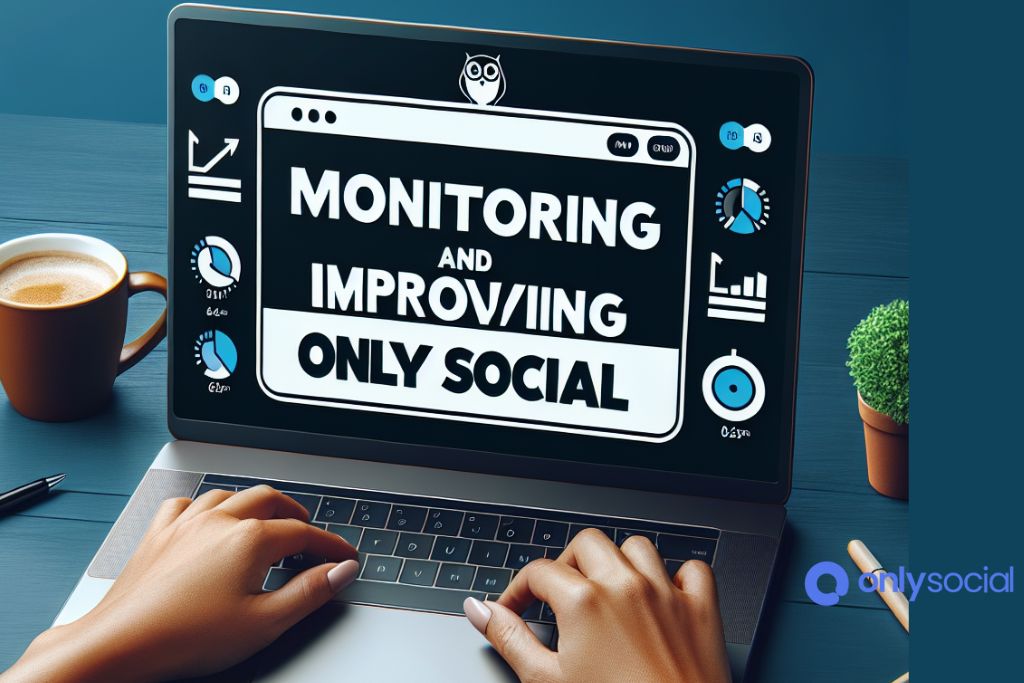Effective Content Marketing Strategy: 2024 Proven Steps to Transform Your Plan into a Success Story

In the rapidly evolving digital landscape of 2024, crafting an effective content marketing strategy has transcended from being merely beneficial to absolutely critical for any business aiming to make a significant impact online. As the heartbeat of digital marketing, a strategically formulated content marketing plan not only enhances brand visibility but also establishes trust, educates your audience, and ultimately, drives profitable customer action. However, with the overwhelming amount of content fighting for attention on various platforms, the question isn’t whether you should invest time and resources into content marketing; it’s how to do so most effectively.
The essence of an effective content marketing strategy lies in understanding the delicate balance between what your audience craves and how you can deliver that content in a way that resonates with them deeply, making your brand not just seen but felt. This approach goes beyond merely pushing content out; it’s about creating meaningful connections and providing value that echoes your audience’s needs, interests, and challenges.
Navigating through this complex and ever-changing environment requires a roadmap, a comprehensive plan that anticipates trends embraces innovation, and focuses intently on the metrics that matter. It’s about setting the foundation right, with an unwavering focus on quality, relevance, and consistency, three pillars that ensure your content not only reaches its intended audience but also inspires action. In this context, an effective content marketing strategy becomes your guide, enabling you to chart a course through the digital noise and connect with your audience in a way that’s both impactful and enduring.
Table of Contents [show]
Foundation of Your Content Marketing Strategy
The bedrock of any effective content marketing strategy lies in its foundation—understanding the ‘why’, ‘who’, and ‘how’. Building this foundation requires meticulous planning and insights. It’s about laying the groundwork that ensures every piece of content aligns with your brand’s goals and resonates with your target audience.
Setting Clear Objectives
An effective content marketing strategy starts with clear, defined objectives. What do you hope to achieve through your content marketing efforts? Whether it’s to increase brand awareness, drive website traffic, generate leads, or boost sales, your goals should be SMART: Specific, Measurable, Achievable, Relevant, and Time-bound. Establishing these objectives early on guides your content creation and helps measure success effectively.
Understanding Your Audience
The heart of an effective content marketing strategy is its audience. Knowing who you’re creating content for is imperative. This step involves conducting audience research to gather insights about your target market’s preferences, pain points, and content consumption habits. Creating buyer personas can be a powerful technique to visualize your ideal customer and tailor your content to meet their needs and interests. Understanding your audience ensures your content engages and provides value, fostering stronger connections.
Competitive Analysis
No strategy is complete without analyzing the competitive landscape. A thorough competitive analysis helps identify what content your competitors are creating, where they’re distributing it, and how audiences are engaging with it. This insight not only uncovers gaps in your competitors’ strategies that you can capitalize on but also helps you set benchmarks for your own content’s performance. Tools like SEMrush and Ahrefs can provide valuable data for this analysis, enabling you to craft a strategy that stands out in your industry.
Building a Content Calendar
Organization is key to executing an effective content marketing strategy successfully. A content calendar is an essential tool for planning, organizing, and scheduling your content. It helps ensure a consistent content delivery that’s crucial for keeping your audience engaged and driving your content marketing goals. A well-structured content calendar outlines what content will be published, when, and on what platforms, enabling you to visualize your content strategy over time, manage workflows, and ensure a balanced mix of content types and topics.
Building a solid foundation is the first step toward developing an effective content marketing strategy. It involves setting clear objectives, deeply understanding your audience, thoroughly analyzing the competition, and meticulously planning your content calendar. Each of these elements plays a critical role in ensuring that the content you produce is not only aligned with your business goals but also resonates deeply with your target audience. As we navigate through the rest of the steps in this guide, remember that each strategy’s efficacy is rooted in how well these foundational elements are addressed and integrated into your overall content marketing initiatives.
Content Creation & Optimization
A core component of any effective content marketing strategy is creating content that not only captures attention but also holds it, encouraging readers to take action. However, creating such content requires more than just a creative spark; it requires a systematic approach to both creation and optimization.
Generating Content Ideas
The genesis of an effective content marketing strategy is always a great idea. Finding these ideas demands a deep understanding of your audience’s interests, challenges, and questions. Employ techniques such as keyword research, social media listening, and audience polling to uncover topics that will resonate with your audience. Utilizing tools like Answer the Public can reveal what your audience is searching for online, providing a rich source of content inspiration.
Content Types and Formats
Diversity in content types and formats is essential to keep your audience engaged and cater to different preferences. Your effective content marketing strategy should encompass a mix of blog posts, infographics, videos, ebooks, and more. Each format serves a unique purpose and appeals to different segments of your audience. For example, while blog posts are excellent for in-depth explanations, videos might be better for how-to guides or product demonstrations.
Writing and Designing Your Content
The creation phase of your content should focus on delivering value in a clear and engaging manner. Writing should be accessible and reflective of your brand’s voice, while design should enhance the content’s readability and shareability. Utilize headings, bullet points, and bold text to improve the scannability of written content. For visual content, ensure designs are consistent with your brand’s aesthetic and optimized for the platforms they will be shared.
SEO Optimization
An effective content marketing strategy is incomplete without SEO optimization. SEO ensures your content is discovered by those searching for topics related to your business. This includes researching and integrating relevant keywords naturally, optimizing meta titles and descriptions for click-through rates, and structuring content with SEO-friendly formatting. Additionally, paying attention to back-end elements like site speed and mobile responsiveness will further enhance your content’s visibility and performance in search engine results pages (SERPs).
Executing the principles of content creation and optimization is what transforms a standard content marketing approach into an effective content marketing strategy. This process involves not just generating ideas that speak directly to your audience’s needs but also presenting these ideas in varied and engaging formats. Writing with clarity and a distinct voice, designing with purpose and brand consistency, and adhering to SEO best practices are all fundamental to ensuring your content reaches its intended audience and achieves the desired impact. As you move through these steps, remember that each piece of content is an opportunity to connect with your audience and move you closer to achieving your wider business objectives.
Content Distribution
Effectively distributing content is a pivotal component of any effective content marketing strategy. Creating high-quality, engaging content is just the beginning; the next crucial step is ensuring that this content reaches your target audience where they are most active and receptive. Here’s a look at how to strategically distribute your content across various platforms to maximize impact and engagement.
Choosing the Right Channels
Not all platforms are created equal when it comes to distributing your content. The choice of platform depends on where your target audience spends their time and how they consume content. Analyze the demographics and behavior of your audience on platforms like LinkedIn, Twitter, Facebook, and YouTube to guide where to focus your distribution efforts. For B2B businesses, LinkedIn might be the preferred choice, while B2C companies might find more engagement on Instagram or TikTok. Remember, being selective and strategic about your channels is key to an effective content marketing strategy.
Social Media Marketing
Social media stands out as one of the most potent tools in your distribution arsenal. It not only allows for broad reach and visibility but also encourages interaction and shareability. Tailor your content to fit each platform’s unique format and audience expectation—be it short-form videos for TikTok, detailed posts for LinkedIn, or eye-catching images for Instagram. Engage with your followers through comments, create shareable content, and consider leveraging paid promotions to increase reach and visibility to a precisely targeted audience.
Email Marketing
Email marketing remains a powerful way to distribute your content directly to people who have already shown interest in your brand. Use this channel to send out newsletters, exclusive content offers, or updates about your latest blog posts or videos. The key is to provide value that keeps your audience engaged and looking forward to your emails. Segmenting your email list based on user behavior and preferences can further personalize the experience and increase the effectiveness of your content distribution efforts.
Influencer and Guest Posting
Collaboration can exponentially increase the reach of your content. Partnering with influencers within your niche can provide access to a larger and potentially more engaged audience. Similarly, guest posting on reputable websites not only directs traffic back to your own site but also enhances your brand’s credibility and authority. Choose partners whose audiences overlap with your target demographic to ensure that your content resonates and drives meaningful traffic.
Effective distribution is a multifaceted and dynamic element of your overall content marketing strategy. By choosing the right channels, engaging with your audience on social media, leveraging email marketing, and collaborating with influencers or through guest posting, you can significantly enhance the visibility and impact of your content. Each of these distribution strategies offers unique benefits and, when used collectively, can contribute to a comprehensive and effective content marketing strategy that captivates your target audience and compels them to engage with your brand.
Monitoring and Improving
For an effective content marketing strategy to truly flourish, it requires continuous monitoring and improvement. The digital landscape, along with audience preferences, evolves rapidly. Staying abreast of these changes and adjusting your strategy accordingly is crucial for maintaining relevance and engagement. Here’s how to ensure your content marketing strategy remains effective through vigilant monitoring and targeted improvements.
Setting Key Performance Indicators (KPIs)
Before you can measure success, you must define what success looks like. Establishing clear, quantifiable KPIs is the cornerstone of any monitoring effort. These metrics can include website traffic, engagement rates (likes, shares, comments), conversion rates, or any other indicators relevant to your specific goals. Having these metrics in place enables you to track the performance of your content and identify areas for optimization.
Utilizing Analytics Tools
Leverage analytics tools to gather data on your content’s performance. Google Analytics can provide comprehensive insights into website traffic, user behavior, and conversion metrics. Social media platforms also offer their own analytics, giving you a glimpse into how your content performs across different channels. Regularly review this data to understand what works, what doesn’t, and why, guiding your strategy towards more effective content creation and distribution.
A/B Testing
A/B testing, or split testing, is a method of comparing two versions of a webpage or content piece to see which one performs better. Implement A/B testing on various elements of your content, such as headlines, call to actions (CTAs), images, or content formats, to continually refine and improve your approach. This ongoing experimentation not only optimizes individual pieces of content but also provides valuable insights that can be applied to future content creation efforts.
Gathering Audience Feedback
Direct feedback from your audience is invaluable. Encourage comments on your posts, conduct surveys, or engage in social listening to understand how your audience perceives your content. This direct line of communication can reveal gaps in your strategy, untapped audience needs, or opportunities for further engagement. Incorporating audience feedback into your strategy ensures your content remains relevant and valuable to your target demographic.
Competitor Analysis
Keeping an eye on your competitors can provide benchmarks against which to measure your own content’s performance. Analyze their content marketing strategies to identify what’s resonating with their audience—which topics they cover, which formats they use, and how they engage with their followers. This analysis not only helps you identify opportunities for differentiation but can also inspire new approaches to your own content strategy.
Monitoring and improving your content marketing strategy is an iterative, ongoing process. By setting clear KPIs, leveraging analytics, employing A/B testing, listening to audience feedback, and observing competitor successes and failures, your strategy can evolve. This adaptability is essential for sustaining an effective content marketing strategy that continues to achieve its desired outcomes amidst the ever-changing digital marketing landscape.
Scaling Your Content Marketing Efforts
Scaling your content marketing efforts is a critical phase in amplifying the impact of an effective content marketing strategy. As your strategy starts to show results, growing and expanding your reach can help capitalize on your momentum, bringing your business objectives within reach. Here are strategic approaches to scaling your content marketing efforts without compromising on quality or engagement.
Content Repurposing
One of the first steps towards scaling your efforts is to make the most out of your existing content. Repurposing content across different formats allows you to reach wider audiences without the need for the constant creation of new content. For example, turning a successful blog post into an infographic, video, or podcast episode can open up new distribution channels and engage different segments of your audience. This approach not only saves time but also reinforces your message across various platforms.
Content Syndication
Syndicating your content on other websites can drastically increase your reach. By publishing your articles or blog posts on platforms with a larger or complementary audience, you can drive new traffic to your website and enhance brand visibility. However, choose your syndication partners carefully to ensure their audience aligns with your target demographic and that the platforms maintain quality and relevance to your niche.
Leveraging User-Generated Content
Incorporating user-generated content (UGC) into your strategy is a powerful way to scale your content efforts. UGC, such as customer testimonials, reviews, or user-submitted photos and videos, not only provides you with additional content but also builds community and trust around your brand. Encourage your audience to share their experiences and feature their content on your platforms, giving them a voice while amplifying your content production.
Automating and Outsourcing Content Creation
As your content needs grow, look into automating parts of the content creation and distribution process. Tools for scheduling social media posts, email marketing automation, and content management systems can save significant time and resources. Additionally, outsourcing content creation to freelancers or agencies can help keep up with content demands without overburdening your internal team. This allows you to maintain a consistent content output while focusing on strategy and optimization.
Building a Content Team
Eventually, scaling your content marketing strategy might mean establishing or expanding a dedicated content team. Having a team focused on different aspects of content production, distribution, and analysis ensures a high-quality of output and a strategic approach to content marketing. As your strategy matures, consider roles such as content strategists, writers, SEO specialists, and social media managers to support and drive your content marketing objectives.
Scaling your effective content marketing strategy involves maximizing the value of existing content, exploring new distribution methods, embracing user-generated content, and possibly automating or outsourcing content creation. As you expand your efforts, keep a focus on maintaining quality, consistency, and strategic alignment with your business objectives. Strategically scaling your content marketing not only enhances visibility and engagement but also positions your business for sustained growth and success in a competitive digital landscape.
BONUS
In the dynamic realm of digital marketing, efficiently managing your social media presence is crucial for executing an effective content marketing strategy. OnlySocial’s Post Planning and Scheduling function emerges as a vital tool in this journey. It empowers you to meticulously plan and schedule your content across all social networks effortlessly. With the capability to manage unlimited social profiles and assure unlimited posting, our platform is designed to streamline your social media strategy, ensuring consistent engagement with your audience. Elevate your content marketing game by leveraging OnlySocial. Start today with a commitment-free 7-day trial today.
Frequently Asked Questions
What is an effective content marketing strategy?
An effective content marketing strategy is a comprehensive plan designed to attract, engage, and retain an audience by creating and distributing relevant, valuable, and consistent content. The ultimate goal is to drive profitable customer action.
How often should I publish new content?
The frequency of publishing new content can vary depending on your industry, resources, and the preferences of your target audience. However, consistency is key. Whether it’s once a week or daily, choose a schedule you can maintain to keep your audience engaged.
How do I know if my content marketing strategy is working?
Evaluate your strategy’s success by monitoring key performance indicators (KPIs) such as website traffic, engagement rates, conversion rates, and social media shares. Regular analysis of these metrics can indicate whether your strategy is effective or needs adjustments.
Can small businesses benefit from content marketing?
Absolutely. Content marketing is scalable, making it suitable for businesses of all sizes. Small businesses can especially benefit as it provides a cost-effective way to build brand awareness, establish expertise, and engage with a target audience without the need for a large advertising budget.
What types of content should be included in my content marketing strategy?
Your strategy should include a mix of content types and formats that appeal to your target audience, such as blog posts, videos, infographics, podcasts, and social media posts. The key is to provide value and address the needs and interests of your audience.
How important is SEO in content marketing?
SEO is crucial in content marketing as it ensures your content is visible and ranks well in search engine results, making it easier for your target audience to find your content. Incorporating SEO best practices, such as keyword research and optimization, enhances the effectiveness of your content marketing strategy.
How can I improve the engagement of my content?
Improving content engagement involves understanding your audience’s preferences and delivering high-quality, relevant content. Utilize storytelling, include compelling calls to action (CTAs), and encourage user interaction through comments and shares. Testing different formats and monitoring their performance can also help identify what resonates best with your audience.
Should I outsource content creation or do it in-house?
The decision to outsource content creation or handle it in-house depends on your resources, expertise, and content needs. Outsourcing can provide access to specialized skills and save time, but in-house content creation can offer more control and alignment with your brand’s voice.
How can I effectively distribute my content?
Effectively distributing your content involves using channels where your target audience is active, such as social media platforms, email newsletters, content syndication sites, and your own website. Tailoring the content format for each channel and promoting your content through paid advertising or influencer partnerships can also increase reach and engagement.
How do I measure the ROI of my content marketing strategy?
Measuring the ROI of your content marketing strategy involves calculating the cost of content creation and distribution, and then comparing it to the revenue generated from content marketing efforts. Key metrics to consider include conversion rates, sales, lead quality, and customer retention rates, which can help in assessing overall profitability and effectiveness.


